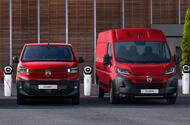Manufacturers push back on electric van targets as commercial sector's transition lags behind passenger cars
Europe’s van makers are strongly pressing the European Union to put the brakes on “financially lethal†emissions targets designed to shift the industry towards 100% electric by 2035, even as signs of EV growth are emerging.
Legislators in the EU and the UK are forcing an accelerated pace of electrification in the van segment, a pace that the van makers say they can’t meet.Â
“It's not reachable for me. It’s not reachable for everybody, except if you crash the market or the financials of the OEMs,†Jean-Philippe Imparato, the outgoing head of Stellantis in Europe, told journalists at last month’s Munich motor show. “It's absolutely lethal for this industry.â€
The UK's electric van market had its biggest sales month yet in September, with 4262 units sold, and overall sales for the year of 22,119 is a rise of 60%, according to figures from the Society of Motor Manufacturers and Traders (SMMT). So far, that equates to an electric share of 9.1%.
Meanwhile, electric sales in the European Union accounted for 9.4% of all new vans sold in the first half of the year.
While those numbers are rising, they’re nowhere near the levels mandated. In the UK, that figure needs to be 16% this year to satisfy the van portion of the ZEV mandate, while the EU requires a 15% drop in CO2 emissions from 2021 levels, a figure that, some van makers say, requires a jump in EV share to around a fifth of the total.
Manufacturers have put their case to the European Commission to plead for laxer targets, which in 2030 drop to an average of 90.6g/km of CO2, down from the 185g/km figure that was allowed before 2025.Â
“The short-term priority is this one,†new Renault Group CEO François Provost told journalists at the sidelines of the Munich event. “For LCV, we are nowhere.â€
For the likes of Ford, Volkswagen, Renault and Stellantis – the main players in the European van market – light commecial vehicles are a key profit driver. “LCV represents between 30% and 40% of the result of the company,†said Imparato.
If van makers don’t shift to electric fast enough, they face huge fines. In a recent report, banking firm Bernstein flagged up that one of the risks for anyone taking a punt on Stellantis as an investment was a potential €2.6 billion (£2.2bn) fine for not electrifying vans fast enough.
Van makers complain that electric vans dent profits and are not wanted by buyers, who continue to do what they’ve always done and buy diesel.Â
“Reducing CO2 remains binary between slow-growing BEV and dominant diesel, suggesting a need for completely new rules,†Philippe Houchois, lead automotive analyst at banking firm Jefferies, wrote in a recent report.
Van makers are lobbying for a smoothing out of the cliff edge. “What is important is to have a CO2 trajectory story on LCV which enables us to play on both legs, and not only on EV investment,†said Renault brand CEO Fabrice Cambolive at the Munich show.
Both Stellantis and Renault are pushing for hybrids to play more of a role. “I think that the hybridisation of diesel is important for our customers,†said Imparato. The company will offer a hybrid option for the 'B22' diesel engine in its larger vans, such as the Vauxhall Movano, he said.
So far this year in the UK, hybrid LCVÂ sales have hit 5807 units with plug-in hybrids on 6548, according to data from New AutoMotive, an independent transport research organisation.
Currently, Ford offers a plug-hybrid option for the best-selling Transit Custom mid-sized van and Ranger pick-up. VW also offers the drivetrain on its versions of those vehicles – the Transporter and Amarok – which it sources from Ford.
The need to boost EV sales as well as reduce overall CO2 has led to the introduction of more car-derived models with the rear seats deleted. Electric examples include the new Skoda Enyaq Cargo and van versions of the Citroën ë-C3 and Dacia Spring. The Toyota Corolla Commercial, based on the estate, is a lower-CO2 hybrid example and has just been joined by the new van version of the Dacia Duster hybrid.
Most LCV makers are still well behind the ZEV mandate in the UK, with Ford lagging with just a 7% share compared with its estimated target of 13.5% (based on the 16% plus flexibilities) according to New AutoMotive. VW is one of the few on target, thanks in part to sales of its ID Buzz electric van, and Stellantis is also close.
Out on front, however, is MG parent SAIC, whose Maxus range offers both electric and combustion vans and pick-ups. Of Maxus’s 5307 sales in the first nine months of this year, 27% were EVs, which puts it well above the mandate threshold and underscores the threat to existing brands posed by Chinese newcomers.
The advantage of Maxus and Geely’s new Farizon van brand is access to cheaper lithium-iron-phosphate (LFP) battery chemistry – a Chinese speciality – that can usefully reduce the price and/or boost profitability. Western brands are starting to make the shift and Renault has said it’ll incorporate the chemistry in its new Trafic E-Tech arriving in 2026.
Van makers are being given a leg-up in the EV transition as they work to bring the cost down and boost the range. The UK has extended the plug-in van and truck grant, which hands out discounts of £2500 for small vans and £5000 for large vans. The discounts will continue until “at least†2027, the government said in August.
Earlier this year, the government also relaxed the rules of the ZEV mandate by allowing van makers to borrow against future sales, which essentially means they have until 2030 to settle any outstanding credit deficits. Van makers can also borrow credits from the car side, if they’re doing well selling electric passenger cars.
The message from van makers, however, is that tinkering around the edges won’t cut it. They want the 2035 ban on combustion-engine sales ripped up for good.

